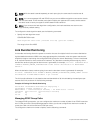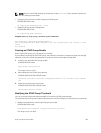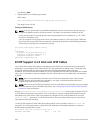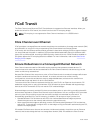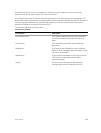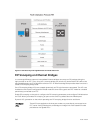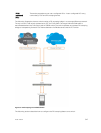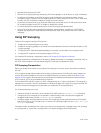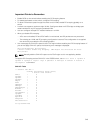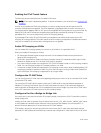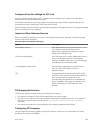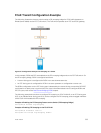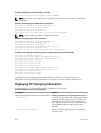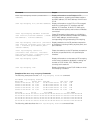
• Allocate CAM resources for FCoE.
• Perform FIP snooping (allowing and parsing FIP frames) globally on all VLANs or on a per-VLAN basis.
• To assign a MAC address to an FCoE end-device (server ENode or storage device) after a server
successfully logs in, set the FCoE MAC address prefix (FC-MAP) value an FCF uses. The FC-MAP value
is used in the ACLs installed in bridge-to-bridge links on the switch.
• To provide more port security on ports that are directly connected to an FCF and have links to other
FIP snooping bridges, set the FCF or Bridge-to-Bridge Port modes.
• To ensure that they are operationally active, check FIP snooping-enabled VLANs.
• Process FIP VLAN discovery requests and responses, advertisements, solicitations, FLOGI/FDISC
requests and responses, FLOGO requests and responses, keep-alive packets, and clear virtual-link
messages.
Using FIP Snooping
There are four steps to configure FCoE transit.
1. Enable the FCoE transit feature on a switch.
2. Enable FIP snooping globally on all Virtual Local Area Networks (VLANs) or individual VLANs on a FIP
snooping bridge.
3. Configure the FC-Map value applied globally by the switch on all VLANs or an individual VLAN.
4. Configure FCF mode for a FIP snooping bridge-to-FCF link.
For a sample FIP snooping configuration, refer to FIP Snooping Configuration Example.
Statistical information is available for FIP Snooping-related information. For available commands, refer to
the FCoE Transit chapter in the Dell Networking OS Command Line Reference Guide.
FIP Snooping Prerequisites
Before you enable FCoE transit and configure FIP snooping on a switch, ensure that certain conditions
are met.
A FIP snooping bridge requires data center bridging exchange protocol (DCBx) and priority-based flow
control (PFC) to be enabled on the switch for lossless Ethernet connections (refer to the Data Center
Bridging (DCB) chapter). Dell Networking recommends also enabling enhanced transmission selection
(ETS); however, ETS is recommended but not required.
If you enable DCBx and PFC mode is on (PFC is operationally up) in a port configuration, FIP snooping is
operational on the port. If the PFC parameters in a DCBx exchange with a peer are not synchronized, FIP
and FCoE frames are dropped on the port after you enable the FIP snooping feature.
For VLAN membership, you must:
• create the VLANs on the switch which handles FCoE traffic (use the interface vlan command).
• configure each FIP snooping port to operate in Hybrid mode so that it accepts both tagged and
untagged VLAN frames (use the portmode hybrid command).
• configure tagged VLAN membership on each FIP snooping port that sends and receives FCoE traffic
and has links with an FCF, ENode server, or another FIP snooping bridge (use the tagged port-type
slot/port command).
The default VLAN membership of the port must continue to operate with untagged frames. FIP snooping
is not supported on a port that is configured for non-default untagged VLAN membership.
348
FCoE Transit



